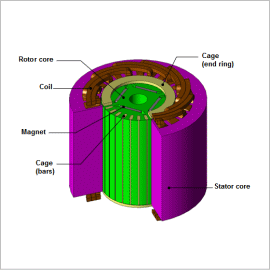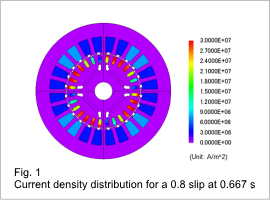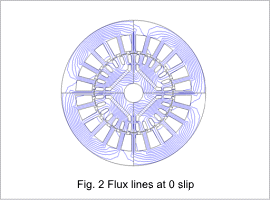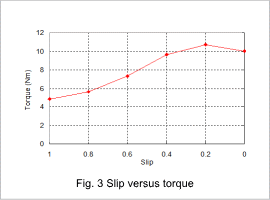*Please prepare a license ID and password for the license administrator.
*It is different from the service for JMAG WEB MEMBER (free membership). Please be careful.
Overview

A self starting permanent magnet motor combines the characteristics of an induction motor and a permanent magnet motor, so it has higher efficiency than an induction motor even without a control device like an inverter. It behaves as an induction motor when it starts, generating torque when the rotor cage first slips against the rotating magnetic field created by the stator and then produces a secondary current. Consequently, this kind of motor has superior starting ability because there is no need to account for the rotor’s start-up position or rotation speed. When the rotation speed increases and the motor synchronizes, the permanent magnet begins to generate the magnetomotive force and produce torque instead of the secondary current, so there is no secondary iron loss. This kind of motor has a weak point, however: The torque falls a great deal when the motor deviates from its synchronicity, and it gets out of step as a magnet motor so the torque variations are large. This is why self starting permanent magnet motors can achieve full-voltage starting with household current and are very efficient while in a synchronous state, but have drawbacks like relatively low starting torque and recovery once they have lost synchronization.
These factors make it so that a magnetic field analysis simulation based on the finite element method is necessary to investigate whether the motor’s characteristics meet the requirements ahead of time.
This Application Note shows how to obtain the current density distribution and slip versus torque curve.
These factors make it so that a magnetic field analysis simulation based on the finite element method is necessary to investigate whether the motor’s characteristics meet the requirements ahead of time.
This Application Note shows how to obtain the current density distribution and slip versus torque curve.
Current Density Distribution

The current density distribution at a 0.8 slip is indicated in fig. 1.
If the slip is large, the motor operates as an induction motor. The induced current largely affects the torque characteristics because the torque is produced by the rotating magnetic field produced in the coils and the current induced in the rotor and cage.
If the slip is large, the motor operates as an induction motor. The induced current largely affects the torque characteristics because the torque is produced by the rotating magnetic field produced in the coils and the current induced in the rotor and cage.
Flux Lines

The flux lines at a 0 slip are indicated in fig. 2.
If the slip is 0, the motor operates as a synchronous motor. The torque is produced by the attractive force of the permanent magnet and the reluctance magnetic flux because the self starting permanent magnet motor operates as an IPM motor.
If the slip is 0, the motor operates as a synchronous motor. The torque is produced by the attractive force of the permanent magnet and the reluctance magnetic flux because the self starting permanent magnet motor operates as an IPM motor.
Slip vs. Torque Curve

The slip versus torque curve is indicated in fig. 3.
The torque of the self starting permanent magnet motor gets smaller as the slip gets larger, reaching a maximum torque at a 0.2 slip.
The torque of the self starting permanent magnet motor gets smaller as the slip gets larger, reaching a maximum torque at a 0.2 slip.


